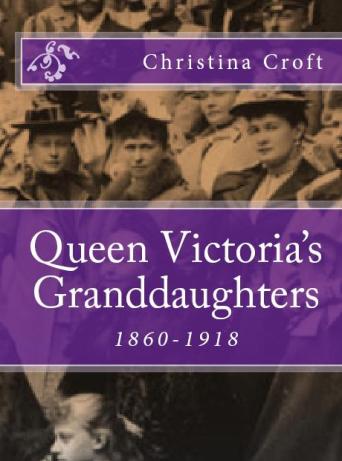
Queen Victoria's Granddaughters - Available in Paperback or Kindle Version
The children of Victoria and Frederick of Prussia:
 1. Wilhelm (‘Willy’), (1859-1941) the future Kaiser
Wilhelm II, suffered a traumatic birth which led to a permanent
deformity of his arm. Blaming his mother
for this defect, he and Victoria’s relationship was often strained and,
to make matters worse, the Prussian Court considered her influence ‘too
English’ and denied her a full role in his upbringing. Erratic and
impulsive, Wilhelm was viewed by many of his contemporaries as
unbalanced but it seems that many of the more noble aspects of his
character have been overlooked or distorted by the erroneous myth that
he was responsible for the outbreak of the First World War.
1. Wilhelm (‘Willy’), (1859-1941) the future Kaiser
Wilhelm II, suffered a traumatic birth which led to a permanent
deformity of his arm. Blaming his mother
for this defect, he and Victoria’s relationship was often strained and,
to make matters worse, the Prussian Court considered her influence ‘too
English’ and denied her a full role in his upbringing. Erratic and
impulsive, Wilhelm was viewed by many of his contemporaries as
unbalanced but it seems that many of the more noble aspects of his
character have been overlooked or distorted by the erroneous myth that
he was responsible for the outbreak of the First World War.“After being with [him] for some time one began to see that his brilliance was mostly superficial and all his conversation studied beforehand. It seemed to me that he anticipated what subjects of conversation would crop up and then got his staff to look up statistics, which he after wards brought out in conversation, with the result that people were astounded at his knowledge. He was particularly good at committing statistics to memory…Quite apart from the superficial acting. The Emperor had great fascination as a conversationalist, as he was always so keen and interested. He practically stood on one’s feet, glaring into one’s eyes and giving grunts of approval, which acted as a spur.” (Frederick Ponsonby)
Various Thoughts About Kaiser Wilhelm
What the Kaiser Really Thought of Hitler
Recommended reading: Shattered Crowns: The Scapegoats by Christina Croft
 2. Charlotte (‘Ditta’) (1860-1919) caused her mother a great deal of anxiety due
to her often erratic behaviour. In recent years it has been suggested
that she was suffering from porphyria, which might explain some of her
mood swings and sometimes bizarre escapades. Eager to escape from
parental control, she married Prince Bernard of Saxe-Meiningen while
still very young and had one daughter, Feodora, whom she often abandoned
to the care of her mother. Throughout the reign of her brother,
Wilhelm, she was known for her mischief-making, and spent much of her
life between bouts of illness, in what Queen Victoria saw as frivolous
and extravagant pursuits. “The great love of amusement,” wrote Queen Victoria, “[is] much to be regretted and then I blame her husband very much. If he allows it what can you say?”
2. Charlotte (‘Ditta’) (1860-1919) caused her mother a great deal of anxiety due
to her often erratic behaviour. In recent years it has been suggested
that she was suffering from porphyria, which might explain some of her
mood swings and sometimes bizarre escapades. Eager to escape from
parental control, she married Prince Bernard of Saxe-Meiningen while
still very young and had one daughter, Feodora, whom she often abandoned
to the care of her mother. Throughout the reign of her brother,
Wilhelm, she was known for her mischief-making, and spent much of her
life between bouts of illness, in what Queen Victoria saw as frivolous
and extravagant pursuits. “The great love of amusement,” wrote Queen Victoria, “[is] much to be regretted and then I blame her husband very much. If he allows it what can you say?” More information about Charlotte
Recommended reading: Purple Secret by John C. Rohl
 3. Henry (1862-1929) played a prominent role in the German Navy, becoming Commander-in-Chief
of the Baltic Fleet at the outbreak of the First World War. He was also
an avid fan of motor cars and aeroplanes and took part in several races
and sporting events. He married his cousin, Irene of Hesse – a happy
marriage, which produced three sons, two of whom inherited haemophilia
from their mother. Following the overthrow of the monarchy in 1918 he
and Irene settled in Hemmelmark. Like his father, Henry died of throat
cancer.
3. Henry (1862-1929) played a prominent role in the German Navy, becoming Commander-in-Chief
of the Baltic Fleet at the outbreak of the First World War. He was also
an avid fan of motor cars and aeroplanes and took part in several races
and sporting events. He married his cousin, Irene of Hesse – a happy
marriage, which produced three sons, two of whom inherited haemophilia
from their mother. Following the overthrow of the monarchy in 1918 he
and Irene settled in Hemmelmark. Like his father, Henry died of throat
cancer.“He was a perfectly straightforward man and never gave one the impression of having any Machiavellian cunning.” (Frederick Ponsonby)
4. Sigismund (‘Sigi’) (1864-1866) was a particular favourite with his mother since she not only was determined to have more control over his upbringing than had been permitted with her elder children, but also he was the first of her children to be breast-fed (to the horror of Queen Victoria!). Sadly, however, while still an infant he contracted meningitis and died. His mother was so distressed that she had a model of him made and placed in his cot, which she regularly visited.
 5. Victoria Moretta (1866-1929) was born in the
midst of the Austro-Prussian War while her mother was still in mourning
for Sigismund. These events seemed to have clouded the rest of her life
which seemed to go from one disappointment to another. Moretta’s
greatest desire was to marry and have children but when the
Prussian Court refused her permission to marry her first love, Prince
‘Sandro’ Battenberg, she believed that no one would ever find her
attractive and became virtually anorexic in her desperation to improve
her figure. Eventually she married a rather ‘scruffy’ prince, Adolf of
Schaumburg-Lippe but again her hopes were dashed when, following a
miscarriage, it was discovered that she would never be able to have
children. After the war and following the death of her husband, Moretta –
who had always been devoted to England – tried to regain ties with her
British cousins but her efforts failed. In later life she re-married
only to discover that her younger husband had simply taken her money and
abandoned her.
5. Victoria Moretta (1866-1929) was born in the
midst of the Austro-Prussian War while her mother was still in mourning
for Sigismund. These events seemed to have clouded the rest of her life
which seemed to go from one disappointment to another. Moretta’s
greatest desire was to marry and have children but when the
Prussian Court refused her permission to marry her first love, Prince
‘Sandro’ Battenberg, she believed that no one would ever find her
attractive and became virtually anorexic in her desperation to improve
her figure. Eventually she married a rather ‘scruffy’ prince, Adolf of
Schaumburg-Lippe but again her hopes were dashed when, following a
miscarriage, it was discovered that she would never be able to have
children. After the war and following the death of her husband, Moretta –
who had always been devoted to England – tried to regain ties with her
British cousins but her efforts failed. In later life she re-married
only to discover that her younger husband had simply taken her money and
abandoned her.For more information about Moretta, follow this LINK
Recommended reading: Queen Victoria at Windsor & Balmoral (Letters from Moretta to her mother) ed. by Jaes Pope-Hennersey
6. Waldemar (‘Waldie’) (1868-1879) was a great favourite with his parents and siblings. An endearing child with a great sense of fun, he also seemed to his mother to be the most intelligent of her sons. Unfortunately, during the diphtheria epidemic of 1878-1879, Waldie contracted the illness and died.
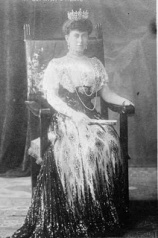 7. Sophie (1870-1932) met and fell in love with Crown Prince Constantine (‘Tino’)
of Greece during her grandmother’s Golden Jubilee in 1887. After their
marriage, she dedicated herself wholeheartedly to her duties in Athens
and converted to Orthodoxy (much to the annoyance of her brother, the
Kaiser) but encountered many difficulties both with the a clash of
culture with the local people and her husband’s infidelity. During the
war, she was in the unfortunate position of being the Kaiser’s sister
(and therefore accused of being a German spy) and that the same time
wishing her country to remain neutral despite pressure from the
Allies. Her husband was eventually forced to abdicate and he and Sophie
lived in exile in Switzerland. Some years later, they were invited to
return to Greece but Constantine was forced to abdicate a second tme in
1922. After her husband’s death, Sophie returned to Germany where she
died of cancer in 1932.
7. Sophie (1870-1932) met and fell in love with Crown Prince Constantine (‘Tino’)
of Greece during her grandmother’s Golden Jubilee in 1887. After their
marriage, she dedicated herself wholeheartedly to her duties in Athens
and converted to Orthodoxy (much to the annoyance of her brother, the
Kaiser) but encountered many difficulties both with the a clash of
culture with the local people and her husband’s infidelity. During the
war, she was in the unfortunate position of being the Kaiser’s sister
(and therefore accused of being a German spy) and that the same time
wishing her country to remain neutral despite pressure from the
Allies. Her husband was eventually forced to abdicate and he and Sophie
lived in exile in Switzerland. Some years later, they were invited to
return to Greece but Constantine was forced to abdicate a second tme in
1922. After her husband’s death, Sophie returned to Germany where she
died of cancer in 1932.Further information about Sophie
8. Margarete (‘Mossy’) (1872-1954) was referred to by her mother as ‘my Benjamin’ (after the beloved youngest son of the Biblical Jacob). Following an unrequited infatuation with Prince Max of Baden, Mossy was suggested as a possible bride for her cousin Prince Albert Victor, and later for the future Tsar Nicholas. Eventually, however, she married Prince Frederick Karl (‘Fischy’) of Hesse-Kassel. During the war two of her young sons were killed in action.
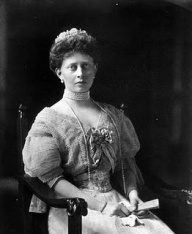 “She is such a love, such a little sunbeam, so good and so
gifted, she will be a charming little person one day, but sometimes I
fear not a very happy one, for she is so sensitive and her little heart
so tender and warm and loving, so clinging that she is sure to suffer in
life.” (Empress Frederick)
“She is such a love, such a little sunbeam, so good and so
gifted, she will be a charming little person one day, but sometimes I
fear not a very happy one, for she is so sensitive and her little heart
so tender and warm and loving, so clinging that she is sure to suffer in
life.” (Empress Frederick)The Children of Edward VII & Alexandra
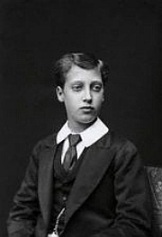 1. Albert Victor (‘Eddy’), Duke of Clarence & Avondale (1864-1892) had inherited
his mother’s deafness which seems to have contributed to his being seen
as unintelligent. Letters have recently come to light, however, which
show that he was very aware of various political situations and had a
definite ideas on solutions to problematic disagreements. His mother
doted on him (as she did on all her children) and he was greatly
loved by his siblings. It was expected that he would one day become king
but in January 1892 he contracted influenza, which developed into fatal
pneumonia. He was only 28 years old.
1. Albert Victor (‘Eddy’), Duke of Clarence & Avondale (1864-1892) had inherited
his mother’s deafness which seems to have contributed to his being seen
as unintelligent. Letters have recently come to light, however, which
show that he was very aware of various political situations and had a
definite ideas on solutions to problematic disagreements. His mother
doted on him (as she did on all her children) and he was greatly
loved by his siblings. It was expected that he would one day become king
but in January 1892 he contracted influenza, which developed into fatal
pneumonia. He was only 28 years old.“His was such a gentle, kind and affectionate nature, that everyone was devoted to him, and it is some consolation to me to know that his memory will be cherished by all his relations and friends. We are all heartbroken and I am sure we shall never quite get over it.” (His sister, Princess Louise)
 2. George (1865-1936) began his career in the navy and remained
fascinated by all things nautical throughout his life. Two other great
passions were stamp collecting and shooting birds. The death of his
elder brother meant that he was suddenly thrust into the limelight as
heir to hsi father. He married his late brother’s fiancée, May of Teck,
and succeeded to the throne as George V in 1910.
2. George (1865-1936) began his career in the navy and remained
fascinated by all things nautical throughout his life. Two other great
passions were stamp collecting and shooting birds. The death of his
elder brother meant that he was suddenly thrust into the limelight as
heir to hsi father. He married his late brother’s fiancée, May of Teck,
and succeeded to the throne as George V in 1910.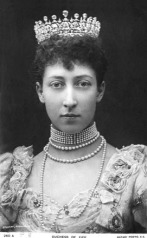 3. Louise (1867-1931) and her younger sisters were simple girls, doted on – almost
to the point of smothering – by their mother and so shy that their
cousin, Marie of Edinburgh, referred to them as the ‘whispering
Waleses’. (“They always, if I can so express it, spoke in a minor
key en sourdine. It gave a special quality to all talks with them, and
gave me a strange sensation, as though life would have been very
wonderful and everything very beautiful, if it had not been so sad.”) Following
her marriage to Alexander, Earl of Fife, in 1889, however, Louise
seemed to blossom. In Decemer 1911, the couple and their daughters were
travelling to Egypt when they were shipwrecked. The family survived the
ordeal but shortly afterwards, Louise’s husband fell ill and died in
Egypt. From then on, Louise lived a quiet life, spending much of her
time in London, where she died in 1931.
3. Louise (1867-1931) and her younger sisters were simple girls, doted on – almost
to the point of smothering – by their mother and so shy that their
cousin, Marie of Edinburgh, referred to them as the ‘whispering
Waleses’. (“They always, if I can so express it, spoke in a minor
key en sourdine. It gave a special quality to all talks with them, and
gave me a strange sensation, as though life would have been very
wonderful and everything very beautiful, if it had not been so sad.”) Following
her marriage to Alexander, Earl of Fife, in 1889, however, Louise
seemed to blossom. In Decemer 1911, the couple and their daughters were
travelling to Egypt when they were shipwrecked. The family survived the
ordeal but shortly afterwards, Louise’s husband fell ill and died in
Egypt. From then on, Louise lived a quiet life, spending much of her
time in London, where she died in 1931.“Vy. pale…and not nearly so pretty a Bride as my dear children & she was too plainly dressed – and had her veil over her face wh. no Pcess ever has & wh. I think very unbecoming & not right.’” (Queen Victoria’s description of Louise at her wedding).
More about Louise
Further details of Louise’s life.
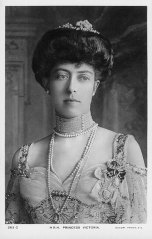 4. Like her sisters, Victoria (‘Toria’) (!836-1935) lived a sheltered life but, unlike her sisters, she did not succeed in escaping from her mother’s ’apron strings’. For
a while she hoped that she might be permitted to marry the widowed
former Prime Minister Lord Roseberry but the constitutional implications
prevented such a match and, what was more, Toria’s mother was extremely
reluctant to part with her daughter. Consequently the princess –
suffering various psychsomatic illnesses – remained as her mother’s
permanent companion until tje Queen’s death in 1925. Toria remained very
close to her brother, King George V, telephoning him every morning
until her death at her home, Coppins, in Buckinghamshire in 1935.
4. Like her sisters, Victoria (‘Toria’) (!836-1935) lived a sheltered life but, unlike her sisters, she did not succeed in escaping from her mother’s ’apron strings’. For
a while she hoped that she might be permitted to marry the widowed
former Prime Minister Lord Roseberry but the constitutional implications
prevented such a match and, what was more, Toria’s mother was extremely
reluctant to part with her daughter. Consequently the princess –
suffering various psychsomatic illnesses – remained as her mother’s
permanent companion until tje Queen’s death in 1925. Toria remained very
close to her brother, King George V, telephoning him every morning
until her death at her home, Coppins, in Buckinghamshire in 1935.More about Victoria
 5. Maud (‘Harry’) (1869-1938) was the most outgoing of Edward VII’s daughters
and in 1896 she married Carl, a younger son of the King of Denmark.
Anticipating a quiet life, she was taken aback when Carl was offered the
throne of Norway in 1905. Despite her shyness (and the frail
constitution she shared with her sisters), Maud rose to the occasion and
became a highly respected and well-loved queen who devoted much of her
time to charitable causes.
5. Maud (‘Harry’) (1869-1938) was the most outgoing of Edward VII’s daughters
and in 1896 she married Carl, a younger son of the King of Denmark.
Anticipating a quiet life, she was taken aback when Carl was offered the
throne of Norway in 1905. Despite her shyness (and the frail
constitution she shared with her sisters), Maud rose to the occasion and
became a highly respected and well-loved queen who devoted much of her
time to charitable causes.“Dear Maud looked very pretty in her white satin dress, with a very long train bordered with orange blossoms, on her head her mother’s wedding veil, & a wreath of orange blossoms. The Archbishop of Canterbury performed the little ceremony, assisted by the Bishops of London & Winchester, other Clergy being also present.” (Queen Victoria describing Maud’s wedding).
More about Maud
The Children of Alice & Grand Duke Louis of Hesse
 1. Victoria (1863-1950) was intellectually extremely gifted with an enquiring mind
and a passion for learning (and for talking!). Something of a tomboy as
a child, she fell in love with and married Prince Louis of Battenberg.
His life as a sailor in the British Royal Navy meant that Victoria
travelled often and spent much of her life in England. Dedicated to
numerous charitable causes, she also educated her own four children to a
high standard. Despite the many tragedies of her life (the early death
of her mother and her husband, and the murder of two of her sisters in
Russia) Victoria remained stoical and a great inspiration to her family:
‘a great and courageous lady.’ (her cousin, Marie Louise). She was the grandmother of the current Duke of Edinburgh.
1. Victoria (1863-1950) was intellectually extremely gifted with an enquiring mind
and a passion for learning (and for talking!). Something of a tomboy as
a child, she fell in love with and married Prince Louis of Battenberg.
His life as a sailor in the British Royal Navy meant that Victoria
travelled often and spent much of her life in England. Dedicated to
numerous charitable causes, she also educated her own four children to a
high standard. Despite the many tragedies of her life (the early death
of her mother and her husband, and the murder of two of her sisters in
Russia) Victoria remained stoical and a great inspiration to her family:
‘a great and courageous lady.’ (her cousin, Marie Louise). She was the grandmother of the current Duke of Edinburgh.“She is very wild and speaks more German than English. I think her rather small but other people say she is not. She goes out walking with her Papa before breakfast quite alone, with her hands in her pockets, and amuses him very much.” (Princess Alice)
“She was…a woman whose absolute integrity seemed to shine out of her bright blue eyes, whose clear reasoning brain was remarkable, whose honesty and singleness of purpose made one feel that one could never tell a lie or indulge in subterfuge or evasion, a woman who had faced many sorrows in life with unflinching courage, and for whom it was possible to feel nothing but respect and admiration.” (Sir George Buchanan)
More about Victoria
Recommended reading: Louis & Victoria by Richard Hough

2. Elizabeth (‘Ella’) (1864-1918) was renowned as ‘the most beautiful princess in Europe’. Turning down a proposal from her cousin, the future Kaiser Wilhelm, she chose to marry Grand Duke Serge Alexandrovich, younger brother of Tsar Alexander III, and was instrumental in bringing her younger sister, Alix, and the Tsarevich Nicholas together. When her husband was blown to pieces by an anarchist, Ella gathered his remains in her own hands before visiting the prison and forgiving the assassin. She dispensed with all her possessions and created a hospital, orphanage and convent of which she became the Abbess. Although she was revered as a saint by the Muscovites, Lenin and the Bolsheviks were determined to annihilate every Romanov in Russia. Ella was hurled into a disused mineshaft and left to starve to death. She is now recognised as a saint by the Orthodox Church.
“She was quite newly married when her beauty burst upon me as a marvellous revelation. Her loveliness was of what used to be called the “angelic” kind. Her eyes, her lips, her smile, her hands, the way she looked at you, the way she talked, the way she moved, all was exquisite beyond words; it almost brought tears to your eyes.” (Her cousin, Marie of Roumania)
“Although she is approaching fifty she has kept her slim figure and her old grace. Under her loose white woollen hood she was as elegant and attractive as in the old days before her widowhood when she still inspired profane passions…Her face in the frame of her long white woollen veil was alive with spirituality. Her delicate features and white skin, the deep, far-away look in her eyes, the low, soft tone of her voice and the luminous glow round her brow all betrayed a being in close contact with the ineffable and divine.” (The French Ambassador to Russia, Maurice Paleologue)
More about Ella
Recommended reading: Most Beautiful Princess by Christina Croft
 3. Irene (1866-1953), born at the end of the Austro-Prussian War and named
after the Goddess of Peace, often seems overshadowed by her
better-known sisters. She married her first cousin, Henry, brother of
Kaiser Wilhelm and lived quietly in Germany even after the overthrow of
the monarchy. Sadly, like her mother and younger sister, Irene was a
haemophilia carrier and her youngest son died as a result of the
condition, aged only four. Her eldest son was also afflicted by the
condition but survived until 1945. Irene died on 11 November 1953
(Armistice Day – a significant date for one had been born at the end
of a war, and whose family had been so divided by the First World War).
3. Irene (1866-1953), born at the end of the Austro-Prussian War and named
after the Goddess of Peace, often seems overshadowed by her
better-known sisters. She married her first cousin, Henry, brother of
Kaiser Wilhelm and lived quietly in Germany even after the overthrow of
the monarchy. Sadly, like her mother and younger sister, Irene was a
haemophilia carrier and her youngest son died as a result of the
condition, aged only four. Her eldest son was also afflicted by the
condition but survived until 1945. Irene died on 11 November 1953
(Armistice Day – a significant date for one had been born at the end
of a war, and whose family had been so divided by the First World War).“She rode with a light touch and loved to dance, as I did. We often danced together accompanied by our own singing. ” (Her brother, Ernst Ludwig)
More about Irene
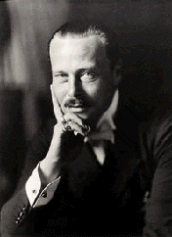 4. Ernst Ludwig (‘Ernie’) (1868-1937) was a
sensitive and artistic child who was greatly affected by the death of
his mother and younger siblings. When he
succeeded his father as Grand Duke of Hesse, Queen Victoria was adamant
that he needed a wife to assist him in his duties and was delighted
when he married his first cousin, ‘Ducky’, Victoria Melita of Edinburgh.
It was not a happy marriage – rumours of Ernie’s bisexuality abounded
and, soon after their grandmother’s death, the couple divorced. Some
years later, Ernie re-married and appears to have been far happier with
his new wife, who bore him two sons. Ernie’s life, however, was filled
with many tragedies – from the bereavements of his childhood, to the
death of his little girl by his first marriage, the separation from his
sisters during the war and the subsequent murder of two of his sisters.
Nonetheless, he was a popular Grand Duke who even earned the respect of
the revolutionaries who were so impressed by his courage in refusing to
flee, that he was allowed to remain living in the family home at
Darmstadt.
4. Ernst Ludwig (‘Ernie’) (1868-1937) was a
sensitive and artistic child who was greatly affected by the death of
his mother and younger siblings. When he
succeeded his father as Grand Duke of Hesse, Queen Victoria was adamant
that he needed a wife to assist him in his duties and was delighted
when he married his first cousin, ‘Ducky’, Victoria Melita of Edinburgh.
It was not a happy marriage – rumours of Ernie’s bisexuality abounded
and, soon after their grandmother’s death, the couple divorced. Some
years later, Ernie re-married and appears to have been far happier with
his new wife, who bore him two sons. Ernie’s life, however, was filled
with many tragedies – from the bereavements of his childhood, to the
death of his little girl by his first marriage, the separation from his
sisters during the war and the subsequent murder of two of his sisters.
Nonetheless, he was a popular Grand Duke who even earned the respect of
the revolutionaries who were so impressed by his courage in refusing to
flee, that he was allowed to remain living in the family home at
Darmstadt.“A kinder dearer brother never was…” (His sister, Alix)
More about Ernst Ludwig
Further thoughts about Ernst Ludwig
Recommended reading: The Correspondence of Empress Alexandra of Russia with Ernst Ludwig and Eleanore, Grand Duke & Duchess of Hesse by Petra H. Kleinpenning
5. Friedrich Wilhelm (‘Frittie’) (1870-1873) was diagnosed with haemophilia when he was three years old. Soon after the diagnosis, he was waving to his brother, Ernie, through an upstairs window, when he slipped out. At first he appeared unharmed but died later that night. His mother never fully recovered from the loss.
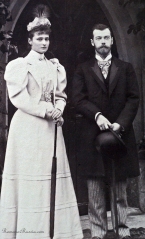 6. Alix (1872-1918) was only six years old when her mother died and consequently
Queen Victoria was eager to play a major part in her upbringing. “She
is like my own child,” the Queen wrote, and perhaps Alix was her
favourite granddaughter. To the Queen’s horror and in spite of her own
early misgivings, Alix chose to marry the future Tsar Nicholas II – it
was a love match which can be seen as one of the greatest love stories
in history. As Empress Alexandra, Alix devoted herself to her adopted
country (and new religion) but her efforts were often thwarted by the
aristocracy and other members of the family. More tragic was the fact
that her only son, Alexei, had inherited haemophilia and Alix lived in
constant fear for his safety. Despite her devotion to Russia, during the
war she and her sister Ella were viewed with deep suspicion because of
their German origins. In spite of this and the subsequent upheavals of
the Revolution and Nicholas’ abdication, her devotion to her country,
her husband and her family remained unwavering. Alix, Nicholas, their
five children and several attendants were murdered in cold blood in
Ekaterinburg in 1918.
6. Alix (1872-1918) was only six years old when her mother died and consequently
Queen Victoria was eager to play a major part in her upbringing. “She
is like my own child,” the Queen wrote, and perhaps Alix was her
favourite granddaughter. To the Queen’s horror and in spite of her own
early misgivings, Alix chose to marry the future Tsar Nicholas II – it
was a love match which can be seen as one of the greatest love stories
in history. As Empress Alexandra, Alix devoted herself to her adopted
country (and new religion) but her efforts were often thwarted by the
aristocracy and other members of the family. More tragic was the fact
that her only son, Alexei, had inherited haemophilia and Alix lived in
constant fear for his safety. Despite her devotion to Russia, during the
war she and her sister Ella were viewed with deep suspicion because of
their German origins. In spite of this and the subsequent upheavals of
the Revolution and Nicholas’ abdication, her devotion to her country,
her husband and her family remained unwavering. Alix, Nicholas, their
five children and several attendants were murdered in cold blood in
Ekaterinburg in 1918.“A very wonderful person; not perhaps as beautiful as her sister [Ella] but very striking. There was a curious atmosphere of fatality about her….One of [her] outstanding qualities was her loyalty to her adopted country.” (Her cousin, Marie Louise)
“The fact is that the Tsarina was nothing if not sincere. Every word from her lips was the true expression of real feelings. Finding herself misunderstood she quickly withdrew back into her shell. Her natural pride was wounded…She adopted a habit of distant reserve which was taken for haughtiness and contempt. But those who came in contact with her in moments of distress knew what a sensitive spirit, what a longing for affection, was concealed behind that apparent coldness.” (Pierre Gilliard, tutor to the Imperial children)
More about Alix
A Beautiful Site with Numerous Videos of Royal Russia
Recommended reading: The Life & Tragedy of Alexandra Feodorovna by Baroness Sophie Buxhoevden
Nicholas & Alexandra by Robert Massie
The Correspondence of Empress Alexandra of Russia with Ernst Ludwig and Eleanore, Grand Duke & Duchess of Hesse by Petra H. Kleinpenning
Most Beautiful Princess by Christina Croft
7. Marie (‘May’) (1874-1878) was said to resemble her elder sister Alix in appearance. Sadly, she was only four years old when the diphtheria epidemic swept through Darmstadt and, in spite of her mother’s careful nursing, May died of the illness.
The children of Alfred and Marie Alexandrovna of Russia
 1. It was expected that Alfred (‘Young Affie’) (1874-1899) would succeed his father
as Duke of Coburg but during his military training in Potsdam,
he contracted syphilis which probably affected him mentally as well as
physically and contributed to his early death. A mystery surrounds the
precise details of what happened but he is believed to have shot himself
during an argument with his mother. He was sent away to recover but
died shortly afterwards. His death would have far-reaching consequences
for his cousin Charles Edward of Albany.
1. It was expected that Alfred (‘Young Affie’) (1874-1899) would succeed his father
as Duke of Coburg but during his military training in Potsdam,
he contracted syphilis which probably affected him mentally as well as
physically and contributed to his early death. A mystery surrounds the
precise details of what happened but he is believed to have shot himself
during an argument with his mother. He was sent away to recover but
died shortly afterwards. His death would have far-reaching consequences
for his cousin Charles Edward of Albany.“It is true, that he was always giddy & wild, as many young men are, & that he contracted an illness of which I know next to nothing, as I have never asked or heard anything about it, one dislikes thinking about it and still more speaking or writing about it. This was neglected and the poor boy led a dissipated life, besides, Potsdam! – that was not the place for him.” (His aunt, Princess Vicky, Empress Frederick)
 2. Marie (‘Missy’) (1865-1927) was probably the most flamboyant of the Queen’s
granddaughters. Renowned for her beauty, she was married, at the age of
seventeen, to Ferdinand, heir to the throne of Roumania and soon
discovered that she had little in common with her diffident husband, who
had no intention of remaining faithful to her. Rather than being
crushed by this revelation, Marie and ‘Nando’ reached a peaceful
solution: Marie helped him to choose his mistresses, and Nando turned a
blind eye to her lovers. With ‘a passion for beauty’ and a love of the
mystical, Marie endeared herself to the people of Roumania. As Crown
Princess, she showed her courage in visiting cholera victims during the
Balkan War, and, as Queen during the First World War, when – largely due
to her influence – Roumania finally joined the Allies, she proved a
great inspiration to her soldiers and her people. In her later years,
she wrote her memoirs, which give a wonderful window into the world of
royalty at the beginning of the century.
2. Marie (‘Missy’) (1865-1927) was probably the most flamboyant of the Queen’s
granddaughters. Renowned for her beauty, she was married, at the age of
seventeen, to Ferdinand, heir to the throne of Roumania and soon
discovered that she had little in common with her diffident husband, who
had no intention of remaining faithful to her. Rather than being
crushed by this revelation, Marie and ‘Nando’ reached a peaceful
solution: Marie helped him to choose his mistresses, and Nando turned a
blind eye to her lovers. With ‘a passion for beauty’ and a love of the
mystical, Marie endeared herself to the people of Roumania. As Crown
Princess, she showed her courage in visiting cholera victims during the
Balkan War, and, as Queen during the First World War, when – largely due
to her influence – Roumania finally joined the Allies, she proved a
great inspiration to her soldiers and her people. In her later years,
she wrote her memoirs, which give a wonderful window into the world of
royalty at the beginning of the century.“It seems to have come very rapidly to a climax. The country is very insecure, the Society dreadful & she is a mere Child & quite inexperienced.” (Queen Victoria on Marie’s engagement)
Another Wonderful Site for More Information about Marie
More Information about Marie
A video of Marie’s visit to the USA
Recommended reading: The Story of my Life by Marie of Roumania
The Last Romantic by Hannah Pakula
 3. Victoria Melita (‘Ducky’) (1876-1936) was cajoled
by Queen Victoria into marrying her cousin, Ernst Ludwig of Hesse (see
above) but already she had fallen
in love with a Russian cousin, Kyril, but the Orthodox Church forbade
marriage between first cousins. Soon disillusioned with life with Ernst
Ludwig, she was intrumental in spreading the stories of his preference
for young men and very soon after the death of their grandmother, the
couple were divorced. Ducky escaped to be with Kyril and in 1905 they
were married without the Tsar’s permission. Banished from Russia, they
settled in Paris until the outbreak of war when the errant Grand Duke
was allowed to return. At the outbreak of the revolution, Kyril hoisted a
red flag over his palace but this did not protect him from the
anti-Romanov fervour and he and Ducky fled to Finland for a while before
moving on to Germany. Ducky died following a stroke in March 1936.
3. Victoria Melita (‘Ducky’) (1876-1936) was cajoled
by Queen Victoria into marrying her cousin, Ernst Ludwig of Hesse (see
above) but already she had fallen
in love with a Russian cousin, Kyril, but the Orthodox Church forbade
marriage between first cousins. Soon disillusioned with life with Ernst
Ludwig, she was intrumental in spreading the stories of his preference
for young men and very soon after the death of their grandmother, the
couple were divorced. Ducky escaped to be with Kyril and in 1905 they
were married without the Tsar’s permission. Banished from Russia, they
settled in Paris until the outbreak of war when the errant Grand Duke
was allowed to return. At the outbreak of the revolution, Kyril hoisted a
red flag over his palace but this did not protect him from the
anti-Romanov fervour and he and Ducky fled to Finland for a while before
moving on to Germany. Ducky died following a stroke in March 1936.“She will not be missed in [Hesse] as she never made herself beloved nor showed any liking for the country, alas!” (Her sister-in-law, Empress Alexandra)
“[her talent for decorative art] is wonderful and she could earn her living at any moment and a very good living making designs for wallpapers, chintzes etc. She draws unerringly, never rubbing out or correcting a single line, and her taste is excellent…she works hard as if her livelihood depended upon it.” (Queen Victoria’s Lady-in-Waiting, Marie Mallett)
More information about Victoria Melita
 4. Alexandra (‘Sandra’)
(1878-1942) was somewhat overshadowed by her more flamboyant sisters
but her marriage – to Prince Ernst of Hohenlohe-Langenburg – was
probably the happiest. During the First World War, she worked as a Red
Cross Nurse and remained in Germany following the demise of the
monarchy.
4. Alexandra (‘Sandra’)
(1878-1942) was somewhat overshadowed by her more flamboyant sisters
but her marriage – to Prince Ernst of Hohenlohe-Langenburg – was
probably the happiest. During the First World War, she worked as a Red
Cross Nurse and remained in Germany following the demise of the
monarchy.
5. Like her elder sister, Ducky, Beatrice (‘Baby Bea’) (1884-1966) fell in love with a Russian cousin – Grand Duke Michael, brother of Tsar Nicholas II. When it became clear that Michael would not marry her, Beatrice fell into a histrionic depression. Some years later she married Alfonso, Duke of Galliera, a cousin of the King of Spain, but either because Beatrice refused the king’s advances, or – as scandalmongers said - she upset the Queen by flaunting a relationship with the king, she and Alfonso were sent away from Spain for some time. During the Spanish Civil War, their Spanish estates were seized and one of their sons was killed in action. Beatrice outlived all her siblings, dying at the age of 82 in 1966.
“Bee was somewhat critical at any early age.” (Her cousin, Victoria of Hesse)
More about Beatrice
The children of Helena and Christian of Schleswig-Holstein
1. Christian Victor (‘Christle’) (1867-1900) was a happy and endearing child who was the first of Queen Victoria’s family to attend public school. After his education at Weillington College and Oxford, he attended Sandhurst and was commissioned in the Rifle Corps. A keen sportsman, he took part in various military campaigns but during the Boer War, he contracted malaria and died of enteric fever. He was buried in Pretoria. His sister, Marie Louise, recounts an interesting story of meeting him after his death .
“Nothing can beat Lenchen’s boy – who one really sees grow daily – He is a splendid fellow.” (Queen Victoria)
More about Christian Victor
 2. While Christian Victor served in the British Army, his younger brother, Albert (‘Abby’)
(1869-1931) became an officer in the Kaiser’s Prussian Army. During the
First World War, however, the Kaiser understood his predicament and
ensured her would not be involved in active service: Abby & The Kaiser.
Shortly before his death in 1931, Albert wrote to a young woman who had
been brought up by a Jewish family, acknowedging that he was her
father. His sisters, Thora and Marie Louise, also made contact with the
young woman and accepted her as his daughter.
2. While Christian Victor served in the British Army, his younger brother, Albert (‘Abby’)
(1869-1931) became an officer in the Kaiser’s Prussian Army. During the
First World War, however, the Kaiser understood his predicament and
ensured her would not be involved in active service: Abby & The Kaiser.
Shortly before his death in 1931, Albert wrote to a young woman who had
been brought up by a Jewish family, acknowedging that he was her
father. His sisters, Thora and Marie Louise, also made contact with the
young woman and accepted her as his daughter.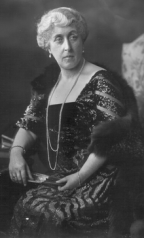 3. Helena Victoria (‘Thora’) (1870-1948) was devoted to her family and, despite
meeting with various suitors, remained unmarried. She took a great
interest in politics and was involved in many charitable organisations
and, during the First World War, she travelled to France to visit the
troops.
3. Helena Victoria (‘Thora’) (1870-1948) was devoted to her family and, despite
meeting with various suitors, remained unmarried. She took a great
interest in politics and was involved in many charitable organisations
and, during the First World War, she travelled to France to visit the
troops.“She had such wonderful judgement, was so clear-headed and wise, and was so loyal and strong in her affections. With it all, she was very humble and very diffident about her own gifts.” (Her sister, Marie Louise)
4. While attending the wedding of her cousin, Moretta, Marie Louise (1870-1956) fell instantly in love with the dashing Prnce Aribert of Anhalt. Encouraged by the Kaiser, the couple were soon married but, on arriving in Anhalt, Marie Louise discovered that she was merely a cover to conceal her husband’s homosexuality. Lonely and depressed, Marie Louise became ill and with her husband’s permission, travelled abroad to recuperate. While in Canada, she received word that she was summoned to Anhalt to face divorce proceedings since she had abandoned her husband. Queen Victoria came to her rescue and Marie Louise settled in England where she undertook numerous charitable works and travelled a great deal before writing her wonderful memoirs.
More about Marie Louise
Recommended reading: My Memories of Six Reigns by Princess Marie Louise
5. Harald (born and died May 1876)
The children of Arthur and Louise of Prussia
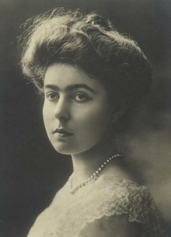 1. Margaret (‘Daisy’) 1882-1920 spent much of her childhood with Queen Victoria
as her parents were travelling abroad. In 1905 she married Gustav
Adolf, heir to the Swedish throne – a love match, which produced five
children. As Sweden remained neutral during the First World War, Daisy
was able to convey messages between her cousins on opposing sides and
also worked closely with the Red Cross. In 1920, while expecting her
sixth child, she suddenly became ill with chicken pox and died at the
age of only 38.
1. Margaret (‘Daisy’) 1882-1920 spent much of her childhood with Queen Victoria
as her parents were travelling abroad. In 1905 she married Gustav
Adolf, heir to the Swedish throne – a love match, which produced five
children. As Sweden remained neutral during the First World War, Daisy
was able to convey messages between her cousins on opposing sides and
also worked closely with the Red Cross. In 1920, while expecting her
sixth child, she suddenly became ill with chicken pox and died at the
age of only 38.“She was unique: she possessed the most beautiful character and I can honestly say was beloved by all who had the privilege of knowing her.” (Her cousin, Marie Louise)
More about Margaret
 2. Arthur (1883-1938) was born in Windsor Castle and educated at Eton. Following
the death of his uncle, Alfred, the Duchy of Coburg was offered to his
father but neither he nor Arthur accepted it. Instead, Arthur pursued a
military career in the British Army, serving in both the Boer War and
the First World War. In 1913 he married Alrexandra, Duchess of Fife, the
daughter of his cousin Louise of Wales and in 1920 was appointed as
Governor General of South Africa. He died of stomach cancer at the age
of 55, pre-deceasing his father.
2. Arthur (1883-1938) was born in Windsor Castle and educated at Eton. Following
the death of his uncle, Alfred, the Duchy of Coburg was offered to his
father but neither he nor Arthur accepted it. Instead, Arthur pursued a
military career in the British Army, serving in both the Boer War and
the First World War. In 1913 he married Alrexandra, Duchess of Fife, the
daughter of his cousin Louise of Wales and in 1920 was appointed as
Governor General of South Africa. He died of stomach cancer at the age
of 55, pre-deceasing his father.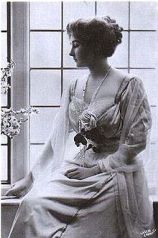 3. Patricia (‘Patsy’) (1886-1974) was a desperately shy child due primarily to her mother’s severity.
While her elder sister often stayed with Queen Victoria, Patricia was
taken on her parents’ travels and consequently was more often under her
mother’s influence. A very gifted artist and strikingly beautiful,
newspapers – to Patsy’s horror – speculated that she was about to be
married, even reporting that she and and brother of Tsar Nicholas were
engaged, but Patsy remained single, assisting her father in his role as
Governor of Canada throughout the First World War. In 1919, however, she
succeeded in persuading her father to allow her to marry a commoner,
Alexander Ramsay. On her marriage she relinquished her royal titles
and became simply Lady Patricia Ramsay. She continued her artistic
pursuits until her death in 1974.
3. Patricia (‘Patsy’) (1886-1974) was a desperately shy child due primarily to her mother’s severity.
While her elder sister often stayed with Queen Victoria, Patricia was
taken on her parents’ travels and consequently was more often under her
mother’s influence. A very gifted artist and strikingly beautiful,
newspapers – to Patsy’s horror – speculated that she was about to be
married, even reporting that she and and brother of Tsar Nicholas were
engaged, but Patsy remained single, assisting her father in his role as
Governor of Canada throughout the First World War. In 1919, however, she
succeeded in persuading her father to allow her to marry a commoner,
Alexander Ramsay. On her marriage she relinquished her royal titles
and became simply Lady Patricia Ramsay. She continued her artistic
pursuits until her death in 1974.“Tall, beautiful, gifted, and a brilliant artist.” (Her cousin, Marie Louise)
The children of Leopold and Helen of Waldeck-Pyrmont
1. Alice (1883-1981) was only one year old when her father died but her mother ensured that her childhood was happy and Alice was of a cheerful disposition by nature. In 1904 she married Alexander of Teck (brother of the future Queen Mary), who succeeded her cousin, Arthur, as Governor of South Africa. During the First World War, she was saddened by the fact the her brother, Charles Edward (see below) was on the opposing side and, even after the war, he was refused entry to Britian. She travelled a great deal throughout her life and outlived all the rest of Queen Victoria’s grandchildren.
“A very fine as well as a very pretty child with enormous blue yes – which we hope will be brown – and is dark. She is a particularly good child.” (Queen Victoria)
“A dear, very merry, healthy little thing; the eyes (fine large ones with black lashes) are becoming quite brown which is what I so much wished – as since the Stuarts we have had no brown eyes in the family.” (Queen Victoria)
More about Alice
“Alice in Wonderland”
Recommended reading: For my Grandchildren by Princess Alice
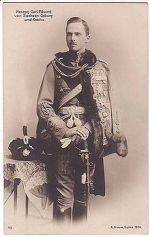 2. Since his father died before he was born, Charles Edward (1884-1954) became
Duke of Albany from the moment of his birth. The tragedy of his life
was that, at the age of sixteen, he also inherited the Duchy of Coburg
and was taken from school in England to the military academy at Potsdam,
where he had a miserable time. When war broke out, he had no choice but
to accept the commission of General in the Germany army, as a result of
which, his cousin, George V, stripped him of the Garter and basically,
all connection with his family in Britain. The collapse of the German
monarchy also led to his being removed as Duke of Coburg. Isolated,
Charles Edward, like many of his German friends and family, saw hope for
a restoration of German pride in the Nazi party. To the horror of many,
he attended George V’s funeral in the brownshirt uniform of the S.A.
During the Second World War one of his sons was killed in action, and
Charles Edward himself was later captured and imprisoned by the
Americans. Once released, he lived out the rest of his life in
semi-seclusion.
2. Since his father died before he was born, Charles Edward (1884-1954) became
Duke of Albany from the moment of his birth. The tragedy of his life
was that, at the age of sixteen, he also inherited the Duchy of Coburg
and was taken from school in England to the military academy at Potsdam,
where he had a miserable time. When war broke out, he had no choice but
to accept the commission of General in the Germany army, as a result of
which, his cousin, George V, stripped him of the Garter and basically,
all connection with his family in Britain. The collapse of the German
monarchy also led to his being removed as Duke of Coburg. Isolated,
Charles Edward, like many of his German friends and family, saw hope for
a restoration of German pride in the Nazi party. To the horror of many,
he attended George V’s funeral in the brownshirt uniform of the S.A.
During the Second World War one of his sons was killed in action, and
Charles Edward himself was later captured and imprisoned by the
Americans. Once released, he lived out the rest of his life in
semi-seclusion.An article about Charles Edward
Thoughts about Charles Edward
The Children of Beatrice and Henry of Battenberg
 1. Alexander (‘Drino’) (1886-1960) and his siblings grew up in their grandmother’s
palaces in close proximity to Queen Victoria who was particularly
attached to these grandchildren. After attending Wellington School, he
spent five years in the Royal Navy before switching to the British army
in which he gained distinction during the First World War. In 1917, he
married Irene Denison and, the following month, was created Marquess of
Carisbrooke.
1. Alexander (‘Drino’) (1886-1960) and his siblings grew up in their grandmother’s
palaces in close proximity to Queen Victoria who was particularly
attached to these grandchildren. After attending Wellington School, he
spent five years in the Royal Navy before switching to the British army
in which he gained distinction during the First World War. In 1917, he
married Irene Denison and, the following month, was created Marquess of
Carisbrooke.“He is full of ability, has great artistic sense, and a very lovely baritone voice.” (His cousin, Marie Louise)
 2. Victoria Eugenie (‘Ena’) (1887-1969), the youngest of Queen Victoria’s granddaughters,
was known as the ‘jubilee baby’ being born in Balmoral in the year of
the Queen’s Golden Jubilee. In 1905 she received a proposal from King
Alfonso of Spain and she converted to Catholicism before her marriage
the following year. The wedding was marred by an anarchist’s bomb, which
left Ena’s wedding dress splattered in blood….and was perhaps symbolic
of the many sorrows she would suffer in Spain. Her husband was
notoriously unfaithful and when it was discovered that Ena was a
haemophilia carrier and her sons had inherited the condition, Alfonso
made no secret of the fact that he blamed his wife for their illness.
Nonetheless, Ena continued to carry out her duties as Queen with great
dignity and devotion to numerous charitable causes. In 1931, following a
Republican coup, the family went into exile and Ena was eventually able
to separate from her husband.
2. Victoria Eugenie (‘Ena’) (1887-1969), the youngest of Queen Victoria’s granddaughters,
was known as the ‘jubilee baby’ being born in Balmoral in the year of
the Queen’s Golden Jubilee. In 1905 she received a proposal from King
Alfonso of Spain and she converted to Catholicism before her marriage
the following year. The wedding was marred by an anarchist’s bomb, which
left Ena’s wedding dress splattered in blood….and was perhaps symbolic
of the many sorrows she would suffer in Spain. Her husband was
notoriously unfaithful and when it was discovered that Ena was a
haemophilia carrier and her sons had inherited the condition, Alfonso
made no secret of the fact that he blamed his wife for their illness.
Nonetheless, Ena continued to carry out her duties as Queen with great
dignity and devotion to numerous charitable causes. In 1931, following a
Republican coup, the family went into exile and Ena was eventually able
to separate from her husband.More about Victoria Eugenie
And more about Victoria Eugenie
An interesting article about Victoria Eugenie’s Engagement
The first in a series of videos of Victoria Eugenia (in Spanish)
 3. Leopold (1889-1922) like his uncle and namesake, had possibly inherited haemophilia
and, following an illness in 1910, he became lame. Nonetheless he
joined the King’s Rifle Regiment and served in a non-active role
throughout the war. He died of complications during an operation on his
hip at the age of thirty-two.
3. Leopold (1889-1922) like his uncle and namesake, had possibly inherited haemophilia
and, following an illness in 1910, he became lame. Nonetheless he
joined the King’s Rifle Regiment and served in a non-active role
throughout the war. He died of complications during an operation on his
hip at the age of thirty-two.“Little Leopold is my special favourite. ‘I love you, I do,’ he said to me yesterday, bringing me a bunch of white violets, ‘I picked them for you because I love you.’” (His aunt, Vicky, Empress Frederick)
 4. Maurice (‘Plumpy’) (1891-1914), the youngest of Queen Victoria’s grandchildren, was killed in action while serving with the King’s Rifles in Belgium in 1914.
4. Maurice (‘Plumpy’) (1891-1914), the youngest of Queen Victoria’s grandchildren, was killed in action while serving with the King’s Rifles in Belgium in 1914.“Brilliant, handsome, and charming and a typical rifleman in the 60th.” (His cousin, Marie Louise)
To find out more about these cousins during the war, please go to the next page: Royalties in the First World War




1 comment:
This blog is packed full of information. It is very rare to find such an abundance of relevant facts and in one place. The grandchildren are grouped together under the parents name so it is easy to identify who belongs to who.
This is a wonderful jumping off spot for anyone who has an interest in the extended family of Queen Victoria.
Post a Comment